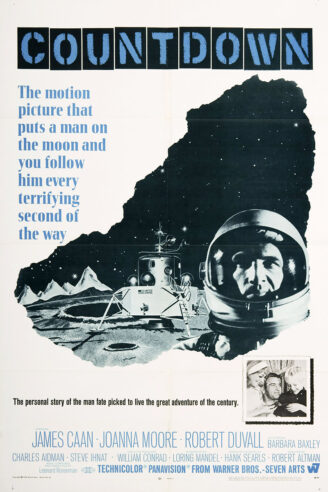The 1960s Space Race saw the United States and the Soviet Union engaged in an ever-evolving game of oneupmanship. One that saw them leaping from first satellite to the first man to the first woman and first multi-person crew to, thanks to President John F. Kennedy’s 1961 declaration before Congress, to putting someone on the Moon first. That goal was reached in July 1969, when Apollo 11’s Neil Armstrong stepped out of the Lunar Module Eagle onto the lunar surface.
In a different world, it might have been another astronaut taking that one giant leap using modified Gemini hardware with such a scenario depicted in Robert Altman’s 1968 movie Countdown.
Based on the 1964 novel The Pilgrim Project by Hank Searls and scripted by Loring Mandel, Countdown depicts the implementation of a crash program by NASA upon the news breaking that the Soviets have not only gone into orbit but are preparing a landing. Called Pilgrim, and originally developed as a contingency plan, it involves a one-way trip that will have an astronaut take a Gemini capsule to the Moon, landing it near a shelter and staying there until Apollo can arrive.
Even better, astronaut Chiz Stewart (Robert Duvall) is ready to fly it in a matter of weeks, thanks to careful planning and training. That is until the Soviets announce their intention to land an all-civilian crew, causing the US government to realize that landing an Air Force colonel will cause Pilgrim to look like a military operation. NASA goes with civilian astronaut and lunar geologist Lee Stegler (James Caan), who not only has to be hurriedly trained by the man he’s replacing but also under the threat of a hurried Soviet effort once word leaks out.
Was a program such as Pilgrim plausible? Perhaps surprisingly, the answer is yes. Throughout the early- to mid-1960s, several Gemini-to-the-Moon proposals were submitted for NASA’s consideration. As detailed in the Lunar Gemini article on Encyclopedia Astronautica, these proposals were wide-ranging, including lunar flybys as part of the August 1961 Gemini proposal (known then as Mercury Mark II) with a landing proposal suggested the following month.
Another plan, put forward in 1967 and based on a 1962 study by McDonnell Aircraft (builders of the capsule), proposed hardware and scenarios similar to those seen in the film. These included the Gemini Lunar Surface Survival Shelter, to be launched before an Apollo landing attempt, and a Gemini Rescue Craft that bears some resemblance to the Pilgrim lander. The most sizable difference being that the Rescue Craft, as its name implies, would have been able to rescue stranded Apollo astronauts and return them safely to the Earth.
Modifications to these proposals plausibly create something akin to Countdown‘s hardware, if not in its exact configuration (with the lander itself being little more than a Gemini capsule stuck atop an Apollo Lunar Module Descent Stage). Would NASA have considered taking such a gamble? Real life offers an analog of sorts with the Apollo 8 mission.
The mission was to be a crewed test-flight of the Apollo Command Module and Lunar Module in medium Earth orbit, set for early 1969. Its flight plan changed in August 1968 thanks to ongoing issues with the Lunar Module and with intelligence reports suggesting the Soviets would attempt to fly a crew around the Moon before the end of the year. Instead, with a launch window opening up around Christmas 1968, four months away, NASA planners decided to send Apollo 8 into lunar orbit in hopes of beating any Soviet effort. The resulting mission was a great success, including giving the world the iconic Earthrise photograph taken by astronaut Bill Anders.
Now granted, four months is a lot longer than a matter of weeks, but it does suggest that the film’s scenario wasn’t too much a work of fiction if the hardware had been in place for it.
The movie itself benefited from NASA’s cooperation. Altman and his crew were allowed to film at several locations at the Kennedy Space Center, wonderfully capturing its mid- to late-sixties look, as well as NASA contractor sites. Indeed, eagle-eyed viewers can spot the Apollo 9 Command Module Gumdrop under construction in the scene where Chiz introduces Lee to the Pilgrim-Gemini variant.
There’s some excellent launch footage presented in widescreen glory (even if the rockets used contradicts earlier dialogue). Not to mention that the attention paid to the costumes and Mission Control set is impressive for the era, and Altman’s use of overlapping dialogue is present already in this early work, albeit edited down by the film’s producer after the fact, adding a much-welcome dose of realism to at times melodramatic scenes.
Unfortunately, the movie suffers in its depiction of the lunar surface looking like precisely what it is: the Mojave Desert with some matte paintings to depict towering rock spires in the distance. Not to mention having Caan’s astronaut walking around in one-g in a Gemini suit with no effort made to portray the one-sixth lunar gravity. The latter choice is even odder given a sequence during training where a “Peter Pan rig” helps simulate lunar gravity. It’s just about forgivable if one is in the right frame of mind to do so.
Of course, by the time Countdown was released in cinemas, the movie itself was on the verge of becoming alternate history. As the Encyclopedia Astronautica article noted above mentioned, the last of the Lunar Gemini concepts received a shoot down even as the movie was going into production. But the fact such ideas were under consideration and that its hardware was entirely plausible (if not in the exact configuration seen on-screen) shows that the movie and its filmmakers weren’t too wide off the mark. Countdown stands then, to quote the title of a 1995 New York Times article on it and other NASA-themed cinematic outings, among “visions of the future, relics of the past” of a Space Race that might have been.
This story was originally published by Sea Lion Press, the world’s first publishing house dedicated to alternate history.





